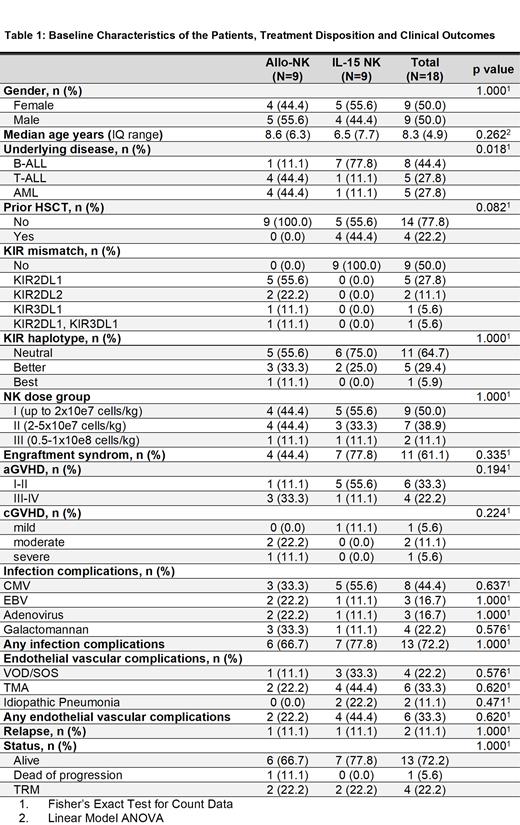Background:
Haploidentical hematopoietic stem cell transplantation (haplo-HSCT) is a highly complicated but effective procedure for high-risk pediatric leukemia in the absence of an HLA-identical donor. Post-transplant relapse is the main problem for patient survival. According to literature, Natural Killer (NK) cells play a potent role as inducers of the graft-versus-leukemia (GvL) effect in haplo-HSCT. The presence of alloreactive NK cells correlates with a lower relapse rate, improved engraftment, decreasing graft-versus-recipient disease (GvHD) and viral infection risk. In the absence of donor-recipient NK cell alloreactivity, other NK cell activation strategies are necessary. We propose a phase I/II clinical trial with dose escalation, multicenter, framed in the GETH, to determine dose-limiting toxicity (DLT) and the maximum tolerated dose (MTD) of a single infusion of alloreactive NK cells (Allo-NK) or NK cells stimulated ex vivo with IL-15 (IL15-NK) after haplo-HSCT in pediatric patients with high-risk leukemias.
Methods:
Eighteen pediatric patients with high-risk leukemia were recruited between September 16, 2020, and May 12, 2023, at 5 hospitals in Spain, Hospital Universitario La Paz, Hospital Universitario Gregorio Marañón, Hospital Universitario Niño Jesús, Hospital Universitario Central of Asturias and Hospital Santa Creu and Sant Pau. Patients were stratified in 2 treatment groups: Allo-NK (n=9) or IL15-NK (n=9), depending on the KIR disparity between donor and recipient. Our phase I/II clinical trial presents a dose-escalation design (3+3). The treatment cohorts are divided into cohort 1 (up to 2x10 7 cells/kg), cohort 2 (2-5x10 7 cells/kg) and cohort 3 (5-10x10 7 cells/kg). We have monitored infections reactivation, as well as, chimerism and engraftment after transplantation. In Allo-NK group, the KIR clone that provides alloreactivity in the NK cell was also tracked. The phenotypic profile and functional capacity of NK cells present in the patient up to 360 days after transplantation have also been analyzed.
Results:
Nine patients (4 in Allo-NK and 5 in IL-15NK) were included in cohort 1, 7 patients (4 in Allo-NK and 3 in IL-15NK) in cohort 2 and 2 patients (1 in Allo-NK and 1 in IL-15NK) in cohort 3. We were unable to complete the dose escalation design initially proposed due to the high weight of some patients and the unavailability of ex vivo expanded NK cells. In IL15-NK group patients presented a higher prevalence of B-ALL (p=0.018) and had received a previous transplant (p=0.082). NK cell infusions of IL15-NK group showed higher expression of CD25 and CD69 receptors and higher functional capacity. In the Allo-NK group, the most prevalent KIR-reactive clone was KIR2DL1 (55.6%). We also observed a tendency for KIR2DL1 alloreactive clone to increase from 30 (8,18%) to 360 (25,63%) days after transplantation. Regarding clinical outcomes in 2 study arms, the incidence of severe (Grades III-IV) acute GvHD was 22.2% and severe chronic GvHD was only observed in 1 (5.6%) patient (Table 1). The incidence any infection or endothelial vascular complications were 72% and 33% respectively. No statistical differences were observed in GvHD, infections and endothelial vascular complications. We found 2 relapses, 1 in each study arm (11.1%). Five patients died, 1 (5.6%) because of disease progression and 4 (22.2%) because transplant related complications (TRM) (Table 1). Dividing patients into the 3 dose-escalation cohorts, we found no significant differences between cohorts in the primary clinical outcomes analysed. One-years overall survival (OS) and disease-free survival (DFS) was 72.22% (CI95% 51.93-100) and GvHD-free/relapse-free survival (GRSF) was 64.1% (CI95% 44.62-92.1), finding no significant differences between either 2 study arms or the 3 dose-escalation cohorts. Regarding the analysis of the NK phenotype, we observed a tendency to increase the expression of CD16 and CD57 receptors between 30 to 360 days after transplantation in both groups.
Conclusions:
Two study arms shows similar data respect to clinical outcome. Patients infused with IL-15-stimulated NK cells showed similar toxicity to the alloreactive NK group. According to dose escalation, we observed no association between increased toxicity and increased number of infused NK cells. We were unfortunately unable to complete cohort 3 because of the cells/kg ratio in some patients.
Disclosures
No relevant conflicts of interest to declare.


